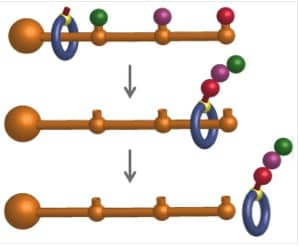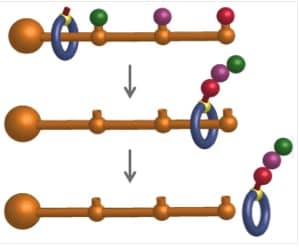
Two weeks ago, a post about a recent overview of molecular machines included this reference:
One of the earliest reviews of artificial molecular machines, and arguably the most comprehensive, titled “Synthetic Molecular Motors and Mechanical Machines” [abstract] was published in December 2006, written by Prof. Leigh in collaboration with Euan R. Kay and Francesco Zerbetto, and was recommended here by Christine Peterson.
A few days after that post, Prof. Leigh and current colleagues Sundus Erbas-Cakmak, Charlie T. McTernan, and Alina L. Nussbaumer published in the American Chemical Society journal Chemical Reviews an updated and comparably comprehensive review titled “Artificial Molecular Machines” [abstract]. Unfortunately, at this writing, it only seems to exist behind a pay wall. At 64 MB and 126 pages, it is more like a small textbook than a review, so the size of the article is at least commensurate with the $35 fee.
The topic is introduced by reference to the 1827 discovery of Brownian motion and the subsequent kinetic theory of matter to introduce the thinking about how motions at the molecular scale can be usefully controlled.
… Here, we review triggered large-amplitude motions in molecular structures and the changes in properties these can produce. We concentrate on conformational and configurational changes in wholly covalently bonded molecules and on catenanes and rotaxanes in which switching is brought about by various stimuli (light, electrochemistry, pH, heat, solvent polarity, cation or anion binding, allosteric effects, temperature, reversible covalent bond formation, etc.). Finally, we discuss the latest generations of sophisticated synthetic molecular machine systems in which the controlled motion of subcomponents is used to perform complex tasks, paving the way to applications and the realization of a new era of “molecular nanotechnology”. …
After a wide-ranging survey of molecular structures, their motions, and properties, the authors conclude with the observation that “molecular machines lie at the heart of every significant biological process”, but that none of our current technologies “exploit controlled molecular-level motion in any way at all: every catalyst, every material, every polymer, every pharmaceutical, and every reagent all function through their static or equilibrium dynamic properties.”
The authors then comment in some detail on challenges that must be overcome for molecular machines to “fulfill their potential”, including the following.
- So far no artificial small-molecule motor can move or rotate autonomously in the presence of a chemical fuel.
- Most of the synthetic molecular machines so far are based on a single functioning part that moves, fluoresces, etc. Systems with multiple integrated parts will be necessary to perform tasks that cannot be accomplished by conventional chemistry.
- Chemists have not yet designed machines that, like macroscopic machines operate stably through many cycles without mistakes, unlike biological molecular machines that operate according to stochastic dynamics.
The authors note that there are still open questions in this research field, such as whether macroscopic machines or biological machines, or some combination of both, will be the most useful models for designing complex artificial molecular machines. Or whether the best environment for integrated systems of molecular machines would be regular arrays within crystalline solids, or surfaces, or in solution.
In meeting these challenges, the authors expect that, although biology and physics will each offer unique insights, “Yet ultimately, while drawing on all of these disciplines for ideas, guidance, and inspiration, such machines have to be designed, built, and operated through chemistry, the central science.”
Not having taken the time to study this review in detail, I cannot comment on the specifics of progress since the last Leigh research group review nine years ago, but it will definitely be very interesting to see what progress is made in the next nine years.
—James Lewis, PhD
